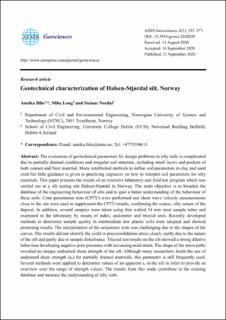| dc.contributor.author | Bihs, Annika | |
| dc.contributor.author | Long, Mike | |
| dc.contributor.author | Nordal, Steinar | |
| dc.date.accessioned | 2022-05-04T11:31:39Z | |
| dc.date.available | 2022-05-04T11:31:39Z | |
| dc.date.created | 2020-09-29T09:37:02Z | |
| dc.date.issued | 2020 | |
| dc.identifier.citation | AIMS Geosciences. 2020, 6 (3), 355-377. | en_US |
| dc.identifier.issn | 2471-2132 | |
| dc.identifier.uri | https://hdl.handle.net/11250/2994160 | |
| dc.description.abstract | The evaluation of geotechnical parameters for design problems in silty soils is complicated due to partially drained conditions and irregular soil structure, including small layers and pockets of both coarser and finer material. Many established methods to define soil parameters in clay and sand exist but little guidance is given to practicing engineers on how to interpret soil parameters for silty materials. This paper presents the results of an extensive laboratory and field test program which was carried out at a silt testing site Halsen-Stjø rdal in Norway. The main objective is to broaden the database of the engineering behaviour of silts and to gain a better understanding of the behaviour of these soils. Cone penetration tests (CPTU) were performed and shear wave velocity measurements close to the site were used to supplement the CPTU results, confirming the coarse, silty nature of the deposit. In addition, several samples were taken using thin walled 54 mm steel sample tubes and examined in the laboratory by means of index, oedometer and triaxial tests. Recently developed methods to determine sample quality in intermediate low plastic soils were adopted and showed promising results. The interpretation of the oedometer tests was challenging due to the shapes of the curves. The results did not identify the yield or preconsolidation stress clearly partly due to the nature of the silt and partly due to sample disturbance. Triaxial test results on the silt showed a strong dilative behaviour developing negative pore pressures with increasing axial strain. The shape of the stress paths revealed no unique undrained shear strength of the silt. Although many researchers doubt the use of undrained shear strength (su) for partially drained materials, this parameter is still frequently used. Several methods were applied to determine values of an apparent su in the silt in order to provide an overview over the range of strength values. The results from this study contribute to the existing database and increase the understanding of silty soils. | en_US |
| dc.language.iso | eng | en_US |
| dc.publisher | AIMS Press | en_US |
| dc.rights | Navngivelse 4.0 Internasjonal | * |
| dc.rights.uri | http://creativecommons.org/licenses/by/4.0/deed.no | * |
| dc.title | Geotechnical characterization of Halsen-Stjørdal silt, Norway | en_US |
| dc.title.alternative | Geotechnical characterization of Halsen-Stjørdal silt, Norway | en_US |
| dc.type | Peer reviewed | en_US |
| dc.type | Journal article | en_US |
| dc.description.version | publishedVersion | en_US |
| dc.source.pagenumber | 355-377 | en_US |
| dc.source.volume | 6 | en_US |
| dc.source.journal | AIMS Geosciences | en_US |
| dc.source.issue | 3 | en_US |
| dc.identifier.doi | 10.3934/geosci.2020020 | |
| dc.identifier.cristin | 1834631 | |
| cristin.ispublished | true | |
| cristin.fulltext | original | |
| cristin.qualitycode | 1 | |

